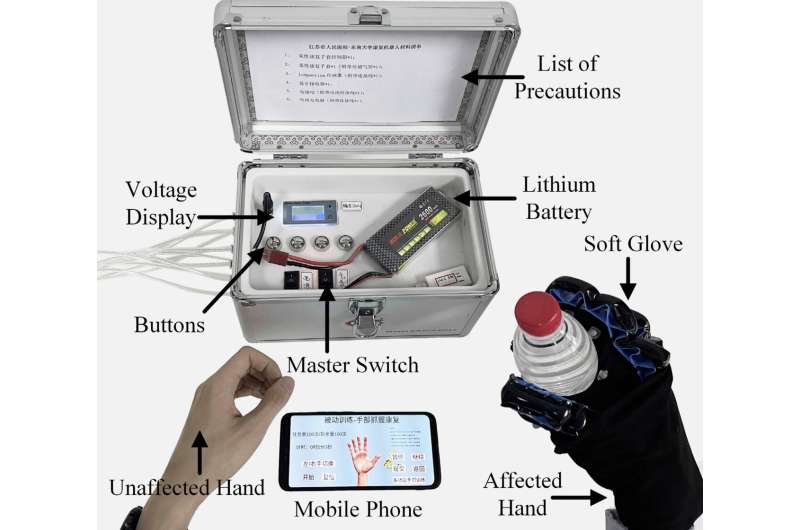August 30, 2023 feature
This article has been reviewed according to Science X's editorial process and policies. Editors have highlighted the following attributes while ensuring the content's credibility:
fact-checked
trusted source
proofread
A soft glove based on honeycomb pneumatic actuators for assistive care and rehabilitation

In recent years, roboticists and computer scientists have developed a variety of highly innovative systems that could assist people with physical disabilities, improve their quality of life and aid their rehabilitation. These systems include soft wearable technologies, such as smart assistive gloves.
Many previously developed smart gloves were built using fabric-based pneumatic actuators (FPAs), which are essentially textiles that can produce specific motions. While some of these systems achieved promising results, they typically can only produce a few motions with little force, which limits their widespread use in rehabilitation and assistive care.
Researchers at Southeast University in China recently created a new soft glove that could achieve a far greater output force than other gloves introduced in the past. This glove, introduced in Transactions on IEEE Transactions on Neural Systems and Rehabilitation Engineering, is based on soft pneumatic actuator with a honeycomb structure.
"Conventional FPAs typically exhibit limited output force, thereby restricting the applications of such gloves," Jianwei Lai, Aiguo Song and colleagues wrote in their paper.
"This paper presents the development of a novel honeycomb pneumatic actuator (HPA) constructed using flexible thermoplastic polyurethane (TPU) coating through hot pressing or ultrasonic welding techniques."
The HPA underpinning the functioning of the new smart glove perform movements by flexing and folding an airbag, which means that it does not fully rely on physical deformations and high air pressure. As a result of its unique design, the actuator can allow fingers on the glove to bend more at their angles and grip objects with greater force.
"Compared to the previously utilized double-layer fabric-based pneumatic actuators (DLFPAs), the HPAs yields a remarkable 862% increase in end output force," Lai, Song and their colleagues explained. "It can produce a tip force of 13.57 N at a pressure of 150 kPa. The integration of HPAs onto a soft pneumatic glove enables the facilitation of various activities of daily living."
To evaluate their soft glove, the researchers carried out a series of clinical trials involving nine patients who had lost the ability to properly move their hand following a stroke and were going through physical rehabilitation. These patients were asked to move their fingers with and without the assistance of the HPA-based glove.
During their clinical trials. the researchers used two tests to evaluate the force with which fingers moved and the grip force. This allowed them to assess the effects that the glove had on the patients' ability to move their fingers, hold onto object and also estimate the extent to which the patients could adequately use their hands.
"The experimental results indicate that when assisted by the glove, the patients' finger metacarpophalangeal (MCP) and proximal interphalangeal (PIP) joints achieved angles of 87.67 ± 19.27° and 64.2 ± 30.66°, respectively," Lai, Song and their colleagues said.
"Additionally, the average fingertip force reached 10.16 ± 4.24 N, the average grip force reached 26.04 ± 15.08 N, and the completion rate of daily functions for the patients increased from 39% to 76%. These outcomes demonstrate that the soft glove effectively aids in finger movements and significantly enhances the patients' daily functioning."
In the future, the soft, HPA-based glove developed by this team of researchers could be commercialized and introduced in health care settings, as a tool for rehabilitation after strokes or injuries. In addition, it could be further updated and used as a prosthetic tool, allowing individuals who are normally unable to move their hands to complete basic manual tasks.
More information: Jianwei Lai et al, A Novel Soft Glove Utilizing Honeycomb Pneumatic Actuators (HPAs) for Assisting Activities of Daily Living, IEEE Transactions on Neural Systems and Rehabilitation Engineering (2023). DOI: 10.1109/TNSRE.2023.3302612
© 2023 Science X Network


















